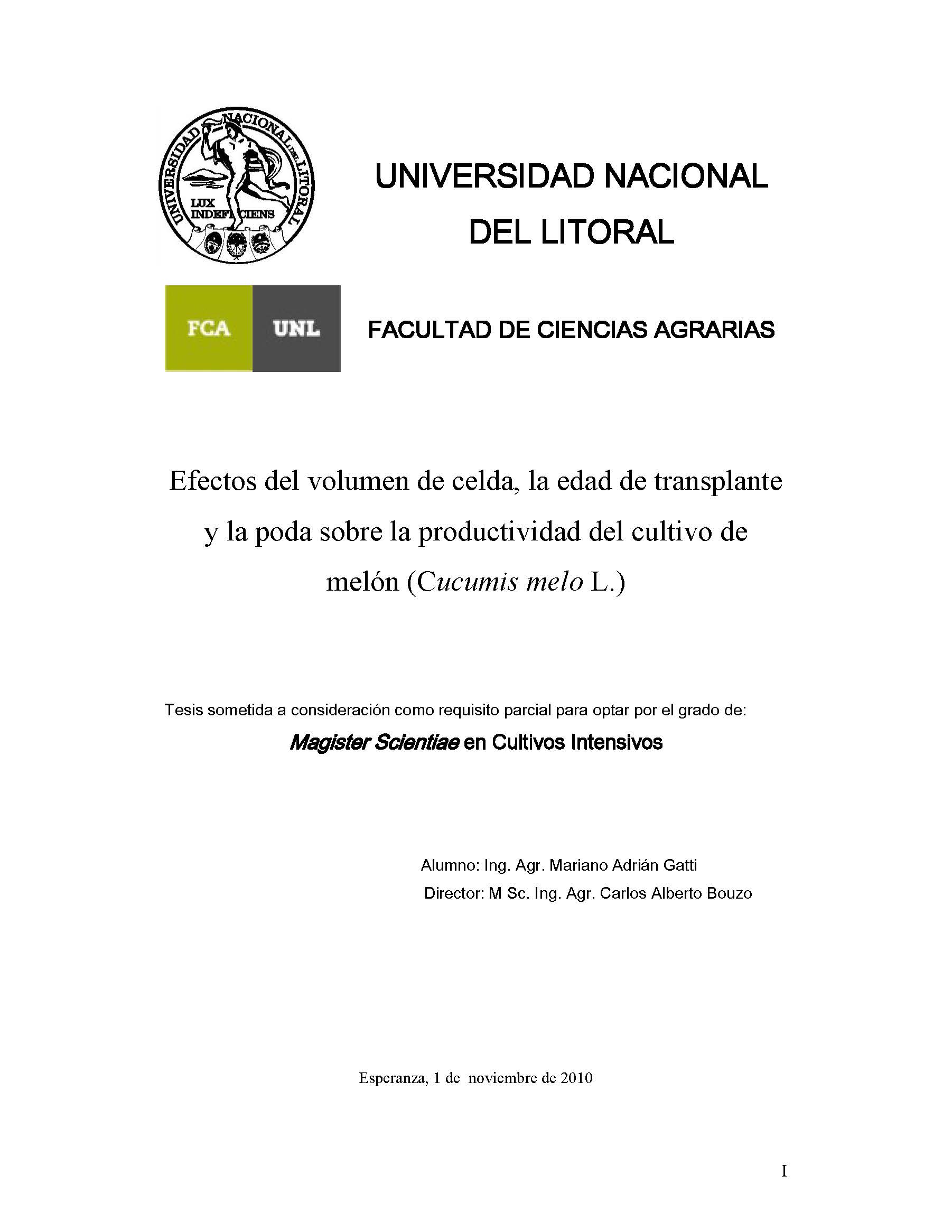Ver ítem
- xmlui.general.dspace_homeCentros Regionales y EEAsCentro Regional Santa FeEEA RafaelaTesisxmlui.ArtifactBrowser.ItemViewer.trail
Efectos del volumen de celda, la edad de transplante y la poda sobre la productividad del cultivo de melón (Cucumis melo L.)
Resumen
El experimento uno consistió en tres celdas: 20, 40 y 120 cm3 y tres edades de transplante 48, 34 y 20 días desde la siembra. El experimento dos utilizó dos celdas: 20 y 120 cm3 y dos edades de transplante 62 y 38 días, luego se realizó poda de la guía principal y guías secundarias a la mitad de las plantas. Para el experimento tres se midieron las mismas variables del experimento dos y una edad de transplante. El objetivo fue evaluar el efecto sobre la
[ver mas...]
El experimento uno consistió en tres celdas: 20, 40 y 120 cm3 y tres edades de transplante 48, 34 y 20 días desde la siembra. El experimento dos utilizó dos celdas: 20 y 120 cm3 y dos edades de transplante 62 y 38 días, luego se realizó poda de la guía principal y guías secundarias a la mitad de las plantas. Para el experimento tres se midieron las mismas variables del experimento dos y una edad de transplante. El objetivo fue evaluar el efecto sobre la precocidad y productividad del melón (Cucumis melo L.). La altura de plantin, área foliar y materia seca, presentaron diferencias a favor de los sembrados en 120 cm3, en tanto que entre 20 y 40 cm3 las diferencias fueron menores. Estas diferencias estuvieron además en función de la edad. La materia seca presentó diferencias por edad. En la etapa de campo, la área foliar se incrementó con la edad de transplante y el volumen de celda utilizado. En el experimento dos se obtuvieron en la etapa inicial, una mayor área foliar en aquellas plantas no podadas. En la cv “Jango” sólo en su edad más joven y en el mayor y menor volumen de celda fue posible registrar menor peso de frutos y rendimiento en Mg.ha-1. En el Experimento uno, como en el experimento dos y tres, no hubo diferencia en estas dos variables, tampoco aun por efecto de la poda. En ninguno de los tres experimentos se obtuvo diferencia de precocidad en la cosecha.
[Cerrar]
The experiment consisted in three cells size of 20, 40,120 cm3 and in three transplant ages of 48, 34, 20 days from sowing. Experiment 2 used two cells size: 20 and 120 cm3 and two ages of transplant: 62 and 38 days. Then, a pruning of the main and secondary guides was made in the middle of the plant. The same variables of experiment two and an age of transplant were measured for xperiment three. The objective was to evaluate the effect on precocity and
[ver mas...]
The experiment consisted in three cells size of 20, 40,120 cm3 and in three transplant ages of 48, 34, 20 days from sowing. Experiment 2 used two cells size: 20 and 120 cm3 and two ages of transplant: 62 and 38 days. Then, a pruning of the main and secondary guides was made in the middle of the plant. The same variables of experiment two and an age of transplant were measured for xperiment three. The objective was to evaluate the effect on precocity and productivity of melon (Cucumus melo L.).The height of the plant, leaves area and dry matter presented differences in favor of 120 cm3 cell size, although differences between cells of 20 and 40 cm3 were smaller.These differences also appeared according to the different ages. The dry matter presented differences according to the ages. In the field stage, the leaves area aumented according to age of transplant and cell volume that was used. In experiment two and during the initial stage, a bigger leaves area was obtained in the plants that had not been pruned. In the case of “Jango”, only in its younger age and smallest and biggest cell volume it was possible to record less fruit weight and yield in Mg.ha-1. In experiment one, as in experiments two and three, there were no differences in these two variables, not even due to the prune effect. No difference in the precocity of harvest was obtained in any of three experiments.
[Cerrar]

Autor
Director de Tesis
Descripción
Tesis para optar al grado académico de Magíster en Cultivos Intensivos, de la Universidad Nacional del Litoral, en noviembre de 2010
Fecha
2010-11
Editorial
Facultad de Ciencias Agrarias, Universidad Nacional del Litoral
Formato
pdf
Tipo de documento
tesis de maestría
Palabras Claves
Derechos de acceso
Abierto
 Excepto donde se diga explicitamente, este item se publica bajo la siguiente descripción: Creative Commons Attribution-NonCommercial-ShareAlike 2.5 Unported (CC BY-NC-SA 2.5)
Excepto donde se diga explicitamente, este item se publica bajo la siguiente descripción: Creative Commons Attribution-NonCommercial-ShareAlike 2.5 Unported (CC BY-NC-SA 2.5)


